 Churches of Christ & Christian Churches in the Pacific Northwest LINN COUNTY, OREGON South of Highway 20. |
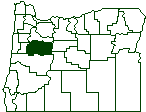
Nov. 5, 2005 |
Brownsville | Crawfordsville | Halsey | Harrisburg | Holley
Muddy | Oak Creek | Peoria | Sand Ridge | Sweet Home
Next Chapter . . . Pioneer Menu . . . Search - - Oldest presented first.
These churches are or were located south of State Highway 20.
A number of churches were established in Linn County during these pioneer years and beyond.
Muddy
Mapquest
We have retained the original name, but Muddy is now Alford, on Muddy Creek just south of Halsey on U.S. 99 West. The town is listed as Muddy on the 1895 county map. It reported 11 members in 1854, and 30 in 1858, making it the oldest congregation in this part of Linn County. Dr. John Perkins, a preaching member of the congregation, was elected to the Legislature in 1864.
The church may have reported using several names. We find "Big Muddy," probably a claim that it was not on the nearby "Little Muddy." We also find a congregation listed as the "Lower Muddy." It may have been the same congregation because the "Little Muddy River" was to the north of it, making this the "Lower Muddy."
In 1855 Eliza Ann Smith of Diamond Hill OakOakwrote to the Christian Record (page 24) about the congregation. Here are excerpts from her December article:
. . . But I am suddenly aroused from my reverie, by the swelling impulses, and endearing entreaties of our elder brother Mulkey, which carries us beyond this vain and transitory world of things, to that New Jerusalem, where we can behold by the eye of faith, and the anticipating glass of hope, those who have washed their robes and made them white in the blood of the Lamb! O! how interestingly, does he portray these scenes of heavenly bliss and glory! Our hearts are comforted, and our faith and hope are strengthened and confirmed, and we are encouraged to wait for that blessed hope, and the realization of our fondest desires.
I love the good old Christian Record, it comes to me as an old friend, always welcome, bearing good and sometimes sad news from afar.
In 1877, the church was still functioning and E. W. Barnes was the circuit-riding preacher. The 1880 census reveals that Jesse Jasper Moss was living in Muddy and he was a "minister." He was living with his son, R. H. Moss and his family. J.J. Moss was again living with his son when he died in 1895 at Birdview, Washington.
Without a doubt, the congregation was absorbed into the Harrisburg Church, 3.5 miles southwest.
Harrisburg
Mapquest
Established in 1863 with 31 members, it built in 1869-70. We quote most of the Harrisburg entry from a document prepared by the church:
In the second Lord's day in Oct., we were over on Muddy, to meeting, (which is our usual place of worship, being about five miles), and brother Philip Mulkey addressed a large audience from parts of the 15th and 19th Psalms, and at the conclusion he gave an invitation to such as were disposed to own their Savior, and two young persons responded favorably, and were immersed the same day about sundown.
In 1856 she wrote again:
Yesterday had the waters permitted, we expected brother Mulkey to visit and preach for us over the Lord's day. But the high waters prevented him from coming.
The following year she wrote:
We have enjoyed the pleasure of Bro. Phillip Mulkey's visits this summer, once per month. Bro. John E. Murphey commenced a meeting on Friday before the first Lord's day in August, and continued over Lord's day; and two individuals came forward and desired to be lambs of the fold, one by immersion, the other had been a living member in the States.
"Record of the church at Harrisburg, the Disciples of
Jesus Christ, whose names appear below, come together as
a Christian Congregation at Harrisburg, Oregon covenanting
with the Lord and with each other to take the Holy Bible as
our only rule of faith and practice," Elder J. E. Murphy presiding. Members present at organization were Wiloby Churchill,
Matilda Ann Churchill, Mary Jane Churchill, Catherine McCully,
Martha Ann Churchill, Samuel McCully, George Leeper, and
Sarah Leeper. Other charter members were Joseph H. Morris,
Sarah R. Morris, G. J. Morris, Eleasana Morris, Thomas
Roach, Maraetta Roach, Charles Roth, Indiana Lane, A. W.
Lane, Salena Martin, A. Humphrey, Mary Humphrey, William
Alingham, Sarah Alingham.

Elder J. E. Murphy is the famed church planter John Ecles Murphy, along with his wife Francis. We continue:
Victor Hoven says of John Ecles Murphy,Among the very early members we find the names Mary A. Grisby admitted by letter, J. R. Cunningham and Nancy A. Cunningham probably the first by confession and baptism and by affilliation H. W. Murphy, R. H. Murphy, Henry Davidson, Sarah Davidson, Wm. M. Davidson and Mary Ann Smith.
The organizational meeting was held on. Saturday, November 7, 1863. Elder Murphy did no Sunday traveling. He led a wagon train from Illinois to Monmouth, Oregon and conducted daily religious services enroute. He proceeded by pony up and down the Willamette Valley conducting services and establishing churches. He was instrumental in starting congregations at Monmouth, Hillsboro and Junction City as well as Harrisburg.
It is thought that the original group met in the home of Geo. J. Morris for a time and later in the Alford school house until a building was erected. They baptized in the river.
As a preacher, John was not strong in teaching, but great in exhortation. He possessed a soft, winning voice. Almost every Saturday he would mount his pony and ride to Harrisburg, or Coburg, or Pleasant Hill, or to other places and preach the gospel.
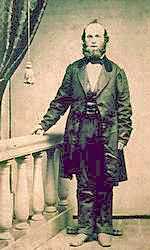
|
Photo courtesy of Clare Buhler |
About this time, overland pioneer Joseph H. Sharp arrived in Harrisburg, because a photo of Sharp in the church records is labeled, "Brother Joseph Sharp, Minister 1866, Harrisburg, Oregon." Joseph and Phoebe may not have been in Harrisburg long because we find them in Latham and Cottage Grove shortly after this. We continue now from the church's own document.
In November of 1867 the church purchased the property on which to build from John and Mary Jane Love. The cost was $100.00. The trustees at this time were Wiloby Churchill, Charles Roth, Thomas Roach and Alfred Humphrey. The present sanctuary was begun In 1869 and finished in March 1870. It was dedicated the first Sunday In April 1870. The timbers for this building were hand hewn. Some of them were donated by Charles Roth, an elder, and others were hauled from Crawfordsville. This was a two days trip each way. These timbers were hauled by Wm. Davidson the grandfather of two of our present deacons -- Stanley Davidson and Wm. Morse. They were used for rafters and beams. They span across the church In solid lengths and are still sturdy and strong. Our forefathers builded well both the spiritual and physical house of God.
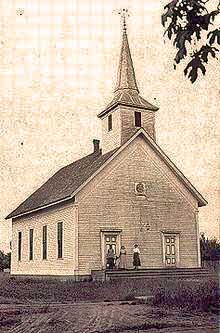 |
Note the weather vane, the full-width steps and the two entry doors. Photo courtesy of Clare Buhler |
In 1877 the church was reorganized with 33 members. Some had moved away, some died and others had "gone back to the world."The elders and deacons in our early church were duly ordained after election by fasting, prayers, and the laying on of hands.
Our forefathers practiced strict discipline. The minutes cite that they withdrew fellowship for "disorderly conduct, for denying the faith, and for going back to the world." They also show record of reclaiming wayward members and welcoming them back into fellowship.
A resolution recorded in 1872 reads "To whom it may concern: we the members and trustees of the Christian Church at Harrisburg assembled do hereby resolve that hereafter this church building shall not be used for any other purpose other than religious worship. Other denominations may have the use of the house when not occupied, by taking proper care of the house, keeping clean etc. But no revelry of any kind will or shall be allowed the use of the building."
Trustee - Samuel Nixon
Elder - Thomas Turner
The records for 1880 show that John Mulkey the grandfather of our elder Bryan Smith baptized two candidates into fellowship here. He was not an ordained minister but like Elder Murphy did lots of preaching In the valley.
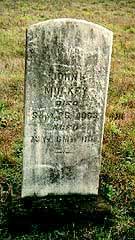 |
JOHN F. MULKEY D I E D Sept. 25, 1903 A G E D 73Ys 6Ms 11 Ds |
The John Mulkey referred to is almost certainly John F. Mulkey who was married to Sarah Ann Sirus. His grandfather John was a friend of Barton Warren Stone. He came overland in 1853 before he married Sarah Ann in 1859. John and Sarah are buried at the West Point Cemetery, just west of I-5 and 1.3 miles south of the Oak Grove Rest Area.
Other prominent members included Walter Huston, his wife Lodemma Shelley Huston and their children R.C., Raymond, Ethel, Veda and Blanche.
The preacher in 1877 was E. W. Barnes and in 1889 was F. E. Jones.
Brownsville Mapquest
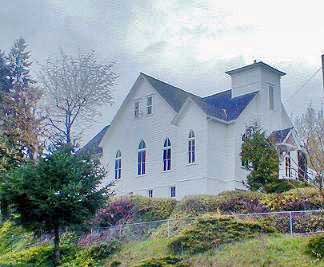 |
The Annual meeting of the Disciples was held at Brownsville in 1874.
John P. McCorkle held a successful gospel meeting here in 1879 with 24 added to the church. The next year he is listed as the preacher in Brownsville.
| Special Gospel Meetings:
About 9 out of 10 additions were by immersion, the rest were by transfer from another congregation. | ||
| 1869 | J. M. Harris | 6 added |
| 1870 | J. M. Harris | 8 added |
| 1873 | J. M. Harris | 16 added |
|
1874
1879 |
"Annual Meeting"
J. P. McCorkle |
45 added
24 added |
L. C. Haulman moved here late in 1892 as the preacher.
Local church historian Mary Lou Nehr can find records showing the present building was built in 1894. Mr. Moyer provided the land and Mr. Matlock built the pews that are still in use.
A congregation was established at Orleans near Albany on Highway 34. Little is known of its past.
Peoria Mapquest
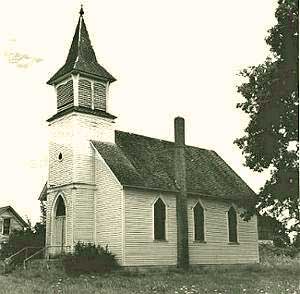
|
Courtesy of the Ben Maxwell Historic Photograph Database at Salem Public Library. |
The church has not left a record of its members or history. We know that descendents of the Powell family from the Central Church settled here because Russell Dean Powell was born here in 1890. We also know that William P. and Mary Ann Preston, overlanders of 1853, settled here by 1875.
The building appears to have been built before 1900. This photo was taken in 1962 by Mr. Ben Maxwell.
There are more than a dozen locations in Oregon with the prefix of Oak. Oak Creek was a community on the portion of Oak Creek east of present-day Albany with the Cowan school house as the center of community activity. This is where the church met and reported 28 members in 1871. The Albany Church would not be launched for at least another decade.
A leading member of the congregation was James Madison Churchill, an overland pioneer of 1853. His parents, Lewis and Mary, came in the same wagon train and may have also been members at Oak Creek. J. M. Churchhill's younger brother Arthur came overland in 1857. He became a physician. Because the Churchill family settled in the area in the late 1850's, the congregation may be much older than we have indicated.
In his Reminiscences, Mac Waller tells of his experiences at Oak Creek.
J. M. Churchill was still a leader of the church in Linn County into the 1890s.
While the log cabin school building has been replaced with one built of milled lumber, the building stood about 3,000 feet east of Interstate 5, just north of Highway 34. Today the building is no longer in use as a school.
Our thanks to Marvin Cole, a resident of Linn County, for his extensive research on Oak Creek, Sand Ridge and several other pioneer Linn County locations.
Sand Ridge
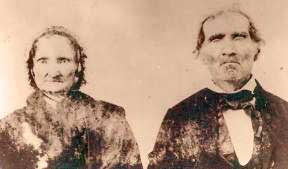
|
She was 58 and he was 56 when they came the 2,300 miles over the Oregon Trail. -- Courtesy of Clarence C. Barnett, Yakima, Washington. |
The church was established in 1855 by Ephraim Barnett and his son George Hays Barnett in the home of Ephraim and Jane Barnett. While both men were farmer-preachers, it was John Alkire Powell from the Central Church east of Albany who organized and led the congregation.
Joel Bradshaw Huston and Thomas M. Ward were the messengers from the congregation to a preaching convention in 1858. By 1871 the church reported 35 members.
|
Members on the 1855-56 list included: Ephraim and Jane Barnett, Barbara Barnett, Catharine Barnett, Eleanor Barnett, George H. Barnett Sr., George H. Barnett Jr., James H. Barnett, John T. Barnett, Robert H. Barnett, Alexander Blair, Mary Blair, John Blazer, Martha Blazer, Eveline Chevelle, Alexander Crawford, Harrison Davis, James O. Douthit, James Gate, Eryenus and Elizabeth Ann Frum, Sarah Jane Frum, George Huston, Joel Bradshaw and Catherine Huston, Sidney and Martha Huston, Adalade Martz, John Miller, Charity Savage, James Tippen, Joel Vail, John and Leah Jane Vernon, Mary E. Ward and Thomas M. and Hannah Ward. -- List courtesy of Clarence C. Barnett, Yakima, Washington. |
J. B. Huston and his wife Catherine -- "Kitty" -- had come over the trail from Tennessee. In the 1870 census they had two sons, Luther and Worth, home working on the farm.
Most of the Huston clan are buried in the Sand Ridge Cemetery. There is a partial listing that includes them.
Thomas and Hannah (or Mary) Ward also farmed and were in Linn County at the time of the 1850 census. We have reason to believe they were pioneers of 1848 from Tennessee. There were enough pioneers from Tennessee in the area that one major road in the vicinity is still called Tennessee Lane.
Holley Mapquest
The Holley Christian Church, four miles southwest of Sweet Home on Highway 228 in Linn County, was established in 1871. The congregation was originally identified as Brethren of the Christian Church. Organized with 40 members, they first met in a school house.
|
Early members included these family names: Barr, Cary, Crawford, Earl, Fields, Finley, Hamilton, Hughes, Lewis, Newton, Powell, Riggs, Shanks, Splawn and Stewart. |
Their first building (1875) was called the Fern Ridge Church House as the area was not yet named Holley. An early settler mistook the Oregon Grapes in the vicinity as a new variety of the holly tree. With a variation in spelling, the name stuck. A few locals believe Holley was named after a Holley in Wisconsin, but no such location has been found.
In the parking lot of today's historic building the sign reads:
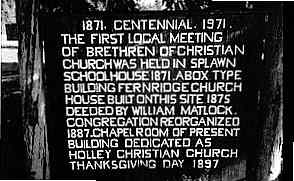 |
The property was given by William and Nancy Matlock. The original pews were built by Bob Matlock. He also made the pews for the Brownsville Christian Church and they are still in use. His work for the Lord has remained on earth well over 100 years.
Follow this link for background on the Matlock family.
Isaac Newton Mulkey was the first minister. On Christmas Day in 1891, he wrote to the Christian Standard:
We closed a meeting last Lord's day at Holly, Linn county with 7 additions. This is our last meeting of four year's work. We served there three years one-fourth time, and last year one-half time. During this time the church gained steadily, with an inreased membership of over one hundred. Brother Southerland, late of California, assisted me in the meeting. Bro. S. will take charge of the work there in the near future.
The spelling and punctuation of the original have been retained.
We believe that I. N. Mulkey had been training a former Baptist minister, George E. Southerland, to take the Holley Church.
The first couple married in the building were Miss Rutha Wright and David W. King in 1892. Mrs. King continued as an active member for 75 years, something of a record. There appears to be a lapse in the congregation's history because in 1887 they reorganized with 30 members.
 The box building was typical of the early Restoration view of what a church building should be. The little building served until the present structure was dedicated in 1897. The drawing at the right is from an artist's view of the original structure with color added.
The box building was typical of the early Restoration view of what a church building should be. The little building served until the present structure was dedicated in 1897. The drawing at the right is from an artist's view of the original structure with color added.
Like the Tabernacle at Turner, the replacement building was built on rocks rather than with a concrete foundation. The rocks have recently been replaced with a conventional concrete foundation. The congregation has preserved the original building while adding space to accommodate their growth. The entire structure is sided with a vinyl siding that simulates the original wood siding.
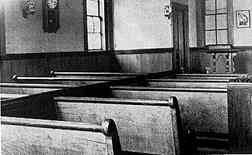
|
The custom of the Holley congregation in its earliest days was for men to sit on one side of the building and women and children on the other. The accompanying photo is NOT from Holley, but does show that some buildings were physically divided to to assure segregated seating. This building is from Washington State.
Revival meetings at Holley were so well attended during the early 1900s that preacher Samuel H. Kimball said of one service, "The church building would not hold the congregation so they took out the windows and people sat in their buggies and farm wagons parked in the grove where they could hear the speaker."
Holley has sent three men into the ministry: Robert Gregory, Claude Wells, and Larry Hake.
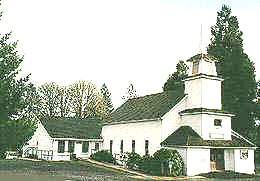
|
Pioneer Reminders: Rice Road, Matlock Bridge.
Halsey Mapquest
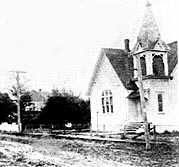 |
located on the SW corner of 2nd and D Streets. |
John E. Roberts was the preacher in 1880 and A. B. Wade concluded his ministry at the end of 1890.
The Davidson family deeded the church lot for a building in 1891. Construction began soon after the lot was available. A. H. Sunderman began his ministry here during the last few weeks of 1893. In 1908, the building was still lighted by lamps.
Mary Smith Knight (Mrs. Elston Knight) came from the Halsey Church.
Crawfordsville Mapquest

|
The Crawford family was active in Christian work in Oregon and Jasper Vincent Crawford preached at Waitsburg in Washington (1893), Enterprise (1898) and Heppner (1902) in Oregon. Before that, he was the first postmaster at Crawfordsville - about 1870. The town did not have saloons in its early days. After many reincarnations, the church has ceased to exist. Those in the area attend the Holley Christian Church or the Brownsville Christian Church.
Crawfordsville is still a picturesque area. Several Christians from northern and central Oregon have chosen to be buried in its peaceful cemetery, not far from Philemon and Lettitia.
The Crawfordsville Cemetery is listed online.
Sweet Home Mapquest
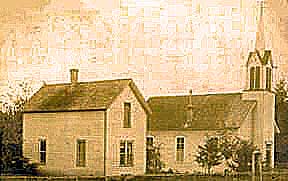
|
The building had originally been an Evangelical Church. It was discontinued about 1906 and the building served as a school and community facility until it was purchased by the Church of Christ in 1918. The new group removed the steeple. Later the building was moved back from the street. In 1948 the structure was rebuilt, using some of the original 1898 lumber.
From that group emerged the Highway 20 Church of Christ and the Riverside Christian Church that meets at the Green River Airport.
From the Highway 20 Church emerged the former McDowell Creek Church located about half way between Lebanon and Sweet Home. (Technically this congregation was in Lebanon, but its ties were to Sweet Home.) The church was located at McDowell Drive and Berlin Road. There is also an a capella congregation at 37th and Long Street in Sweet Home.
Of special interest is the document drawn up and signed in the spring of 1994 by the leaders of the Highway 20 congregation and the McDowell Drive Church putting differences in the past and reaffirming their great brotherhood in Christ.
The Holley Church, which predated the others, also has a Sweet Home address, but is four miles southwest of town on Oregon 228.
Next Chapter: Malheur County or back to History Menu
To DOCHS 7/02
